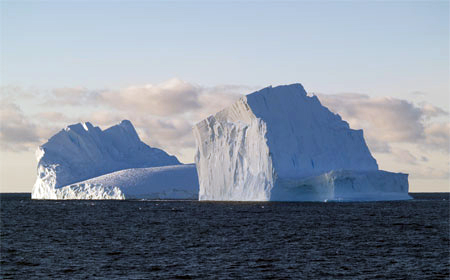|
Need for speedResearchers say rate of ice shelf spreading is prime factor for when icebergs calvePosted December 5, 2008
It won’t help the Titanic, but a newly derived, simple law may help scientists improve their climate models and glaciologists predict where icebergs will calve off from their parent ice sheets, according to a team of researchers. “To predict the future of the ice sheet and to understand the past, we have to put the information into a computer,” said Richard B. Alley Ice sheets, such as those in Antarctica and Greenland, spread under their own weight and flow off land over the oceans. The Ross Ice Shelf “The problem of when things break is a really hard problem because there is so much variability,” Alley said. “Anyone who has dropped a coffee cup knows this. Sometimes the coffee cup breaks and sometimes it bounces.” More on Ice Shelves
The coffee cup’s breaking depends on what it hits and where it hits, but the most important variable is the distance the cup falls or is thrown. Below a certain distance, the cup will always remain intact, while above a certain distance, it will always break; for in-between distances, the results are variable. For iceberg calving, the important variable — the one that accounts for the largest portion of when the iceberg breaks — is the rate at which ice shelves spread, the team reports in the Nov. 28 issue of Science. When ice shelves spread, they crack because of the stresses of spreading. If they spread slowly, those cracks do not propagate through the entire shelf and the shelf remains intact. If the shelf spreads rapidly, the cracks propagate through the shelf and pieces break off. “Spreading explains most of what is observed on the ice sheet,” said Alley, one of the authors of the Science paper. “However, the equations come out a little better if we include a few other things.” These factors are the width of the ice shelf and the thickness. With a narrow shelf between two ridges, for example, the sides hold back the ice movement, slowing the overall movement and making it harder to break the ice. Thicker ice shelves spread more quickly so this affects the location of ice calving as well. The basic equation for ice calving is the rate of spreading times the width of the shelf times the thickness times a constant. The researchers realize that this does not capture the totality of variation in the ice calving process but does account for a large percentage of the variability. NSF-funded research in this story: Richard Alley, Penn State. |



For USAP Participants |
For The Public |
For Researchers and EducatorsContact UsU.S. National Science FoundationOffice of Polar Programs Geosciences Directorate 2415 Eisenhower Avenue, Suite W7100 Alexandria, VA 22314 Sign up for the NSF Office of Polar Programs newsletter and events. Feedback Form |


